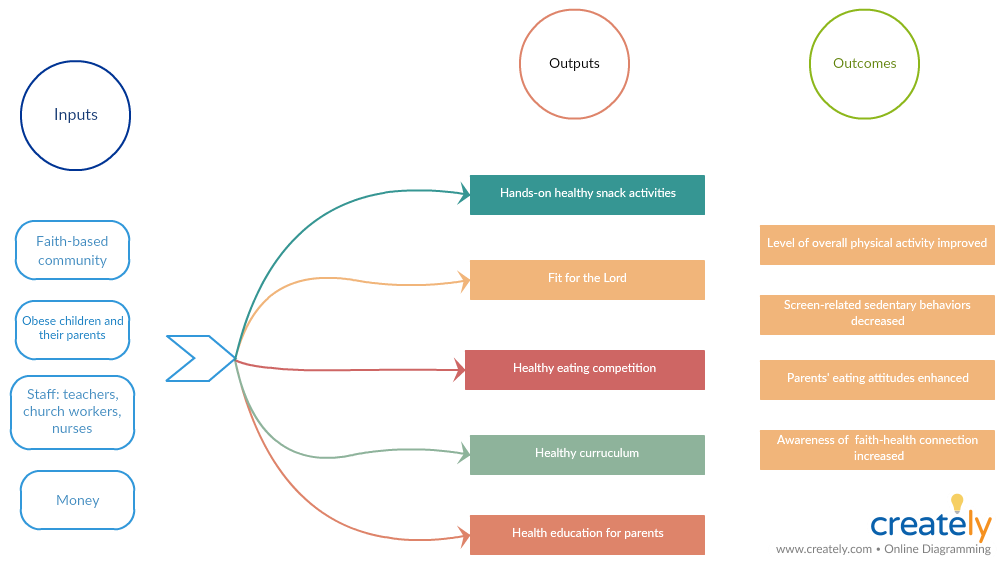Input and Output Diagram

Discussion
Health management information systems (HMIS) compose a relevant and feasible way to collect, store, and analyze data collected from the participants of the study. The information system (IS) can also be understood as a way to provide information support at various levels. Management and the planning of health programs cannot be performed without a properly-designed IS as it ensures the accuracy and transparency of all information and promotes reliable results. Timeliness and completeness may be noted as two more advantages of establishing IS for health-related programs.
For this assignment, the program titled “Summer Obesity Prevention Program for Hispanic Kids” was selected as one of the studies that aim to address this critical problem. This program was prepared specifically to children and their parents from low-income neighborhoods to help them in reducing excessive weight based on the inclusion in the faith-based community. It should be stressed that in the US, almost one out of free children is overweight or obese (Wilmoth et al., 2018). More to the point, the role of faith seems to be significantly decreased within the last years. Therefore, the combination of faith-related goals and those that target obesity elimination among children seems to be a pertinent solution that is likely to resolve both problems.
In order to ensure that all information is collected appropriately, it is essential to create a comprehensive management information system. One of the factors that should be taken into account is that every employee should is in the right position, having relevant knowledge and skills of the intervention to be provided to the target population. The provision of the ogling evidence-based interventions should be prioritized. In addition, staff competence would contribute to more complete and correct data reporting regarding disease progress. In other words, nurses would be expected to observe their patients in the course of the program and report about any changes. The review of the existing tools and their assessment should preface further management information system development.
Data from children and their parents is to be collected via questionnaires that would integrate points about their perceived health improvement, habits, attitudes towards obesity, and so on. Another important factor in designing the IS is to ensure that both quantitative and qualitative data are collected to supplement each other. For example, the former would show how physical activity changed based on numerical data, and the latter would be useful to understand why this occurred. In the proposed program, it is not clear how exactly health care workers collected and reported information. However, one may suggest that in the future management information system, this aspect should be specified in advance.
The eight-stage approach elaborated by the World Health Organization win collaboration with PATH, the global health organizations, seems to be beneficial to use. Even though it was developed for promoting vaccines among various populations, the application to the problem of childhood obesity seems to be appropriate. The following sequence of stages is suggested: define outcomes, form a team, clarify what the system should do, find a solution, choose vendors, estimate implementation costs create a plan for introduction, and manage project risks (“Planning an information,” n.d.). The failure to implement at least one of the mentioned stages may result in data inconsistency and further incorrect results. With regard to the proposed program, the application of the identified structure would make the information system less prone to errors. For example, supervision on reporting and staff training would allow avoiding inaccuracy and, thus, wrong actions towards kids and their parents.
Last but not least, the improvement of HMIS should be regarded as a priority to monitor reporting and its quality. The coordination mechanisms should be reviewed and adjusted to changing requirements in the context of the target program (Sharma, Rana, Prinja, & Kumar, 2016). The interest of staff in the existing management information system should be sustained as well, which would allow them to be more motivated about their work. The resources for further enhancement should be identified, including budget, stakeholders, support areas, and others. Thus, the discussed information system would integrate service delivery, data collection, its storage, decision-making, and the evaluation of findings. Both qualitative and quantitative data should be considered while planning, monitoring, and assessing the proposed program.
References
Planning an information systems project: A toolkit for public health managers. (n.d.). Web.
Sharma, A., Rana, S. K., Prinja, S., & Kumar, R. (2016). Quality of health management information system for maternal & child health care in Haryana state, India. PloS One, 11(2), 1-11.
Wilmoth, S., Pan, M., Correa, L., Martinez, E., Mendoza, R., Sosa, E.,… He, M. (2018). A summer obesity prevention program for Hispanic kids and families through vacation Bible school: A pilot study. Journal of Childhood Obesity, 3(1-2), 1-9.